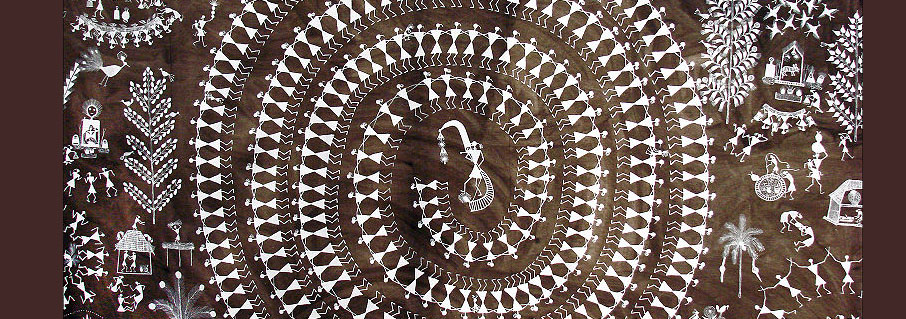Warli painting is a popular form of Indian folk art. Warli art designs feature charming patterns of rustic people, huts, trees and animals. This tribal art of India now finds expression on clothes, pots, canvas etc. Read more about this fascinating Indian art.

Sitha is bending over a paper. Her buddy Vidhya comes in.
 VIDHYA: What are you drawing?
VIDHYA: What are you drawing?
 SITHA: A Warli painting that I am practising for the drawing competition in school.
SITHA: A Warli painting that I am practising for the drawing competition in school.
 VIDHYA: Warli art? What is that?
VIDHYA: Warli art? What is that?
 SITHA: Well it is an Indian folk art, said Sita as she completed the final touches of her drawing.
SITHA: Well it is an Indian folk art, said Sita as she completed the final touches of her drawing.
 VIDHYA: Wow! That’s a pretty picture.
VIDHYA: Wow! That’s a pretty picture.
 SITHA: Well, I also have to do a write up about it to support my drawing so others can get to know about this tribal art of India.
SITHA: Well, I also have to do a write up about it to support my drawing so others can get to know about this tribal art of India.
 VIDHYA: Tribal art? Will you tell me about it?
VIDHYA: Tribal art? Will you tell me about it?
 SITHA: Yes, Sure Jaya. Warli is an art form from Maharashtra, practised by a tribe called Warlis or Varlis. It is an ancient art which is said to have originated around the 10th century A.D.
SITHA: Yes, Sure Jaya. Warli is an art form from Maharashtra, practised by a tribe called Warlis or Varlis. It is an ancient art which is said to have originated around the 10th century A.D.
 VIDHYA: Well, what did they draw?
VIDHYA: Well, what did they draw?
 SITHA: My father said that Warli art designs feature things from daily life and social events connected with their tribes. Warli paintings also feature depictions of festivals. The Warli painters were mostly women in the earlier days, but now men also actively engage themselves in this art form. Figures are drawn on the mud walls of their huts. They draw pictures of figures engaged in hunting, harvesting, sowing, dancing etc. They also draw plants and animals.
SITHA: My father said that Warli art designs feature things from daily life and social events connected with their tribes. Warli paintings also feature depictions of festivals. The Warli painters were mostly women in the earlier days, but now men also actively engage themselves in this art form. Figures are drawn on the mud walls of their huts. They draw pictures of figures engaged in hunting, harvesting, sowing, dancing etc. They also draw plants and animals.
Warli art designs in ritualistic paintings feature the Goddess of fertility drawn within a square. The square in the ritualistic painting is called the “Chauk” or “Chaukat,” which are of two kinds, Devchauk and Lagnachauk. In the middle of the Devchauk they draw the Goddess of fertility called Palaghata. Apart from the Goddess of fertility, they also draw a figure of a horse used by the bride and the groom during the wedding. This forms an important aspect of their tribal weddings and is a mark of auspiciousness.
A certain dance form belonging to their tribe called the Tarpa is also depicted in the Warli paintings. It has concentric circles with a figure of a man blowing a trumpet in the middle, surrounded by men and women holding hands and facing the figure in the centre and going around it.
In those days the figures were drawn on red ochre coloured mud walls of the hut. They are painted in white using rice paste mixed with water and gum used as a thickening agent. Sometimes yellow dots or red dots are also featured in their paintings. The tribal people decorate their walls with Warli paintings during festivals and other social events.
 VIDHYA: The shapes are geometrical with circles, triangles and squares. Why so Sita?
VIDHYA: The shapes are geometrical with circles, triangles and squares. Why so Sita?
 SITHA: Father said that it’s because the tribal people are more close to nature. In the earlier days, they drew circles in their paintings looking at the sun and the moon and triangles by looking at the mountain tops and pointed tree tops. The square could have been added later.
SITHA: Father said that it’s because the tribal people are more close to nature. In the earlier days, they drew circles in their paintings looking at the sun and the moon and triangles by looking at the mountain tops and pointed tree tops. The square could have been added later.
In the modern days, Warli art is done on paper and cloth with new motifs apart from the traditional ones. The Warli art form in the modern days is a massive inspiration for artists and fashion designers.
 VIDHYA: Wow! That was very insightful Sita. Let us do a Warli painting this weekend.
VIDHYA: Wow! That was very insightful Sita. Let us do a Warli painting this weekend.
Sitha nodded gleefully
 SITHA: Good idea! Let us do it.
SITHA: Good idea! Let us do it.
PICTURE CREDITS
https://commons.wikimedia.org/wiki/File:A_Warli_painting_by_Jivya_Soma_Mashe,_Thane_district.jpg
SOURCE: [https://www.flickr.com/photos/72746018@N00/4489190461/ Jivya Soma Mashe (Mus�e du Quai Branly)]
AUTHOR: [https://www.flickr.com/people/72746018@N00 Jean-Pierre Dalb�ra] from Paris, France